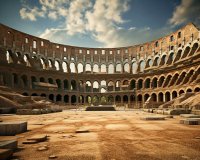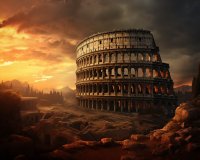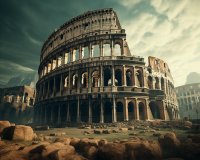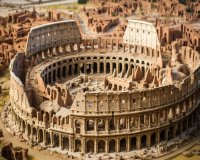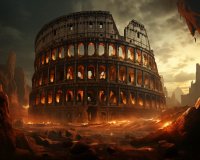Express Access: Unveiling the Wonders of Colosseum and Forum
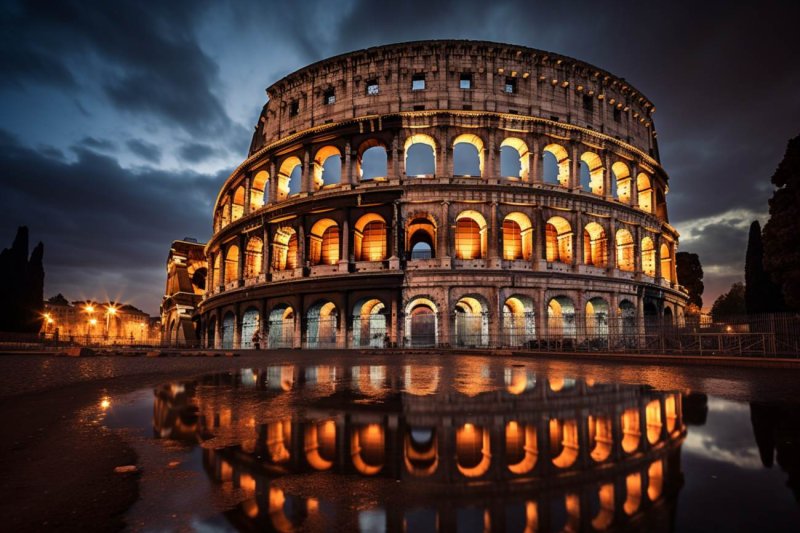
Express Access: Unveiling the Wonders of Colosseum and Forum in Rome
The city of Rome is a treasure trove of history and culture, and two of its most iconic landmarks are the Colosseum and the Roman Forum. These ancient sites are not only a testament to the grandeur of the Roman Empire but also a window into the past that allows us to marvel at the architectural and historical wonders they hold.
The Colosseum: A Triumph of Roman Engineering
The Colosseum, also known as the Flavian Amphitheatre, is one of the most famous and recognizable landmarks in the world. It was constructed in the 1st century AD and could accommodate over 50,000 spectators. This colossal amphitheater was primarily used for gladiatorial contests and various public spectacles.
Stepping into the Colosseum is like stepping back in time. The grandeur of this elliptical structure, with its towering arches and intricate system of seating, is a marvel of Roman engineering. Imagine the roars of the crowd as gladiators battled ferocious beasts or each other in the center of the arena.
As you explore the Colosseum, you can visit the underground passages where gladiators and animals were held before their battles. You'll gain a profound appreciation for the historical significance of this remarkable structure.
The Roman Forum: Heart of Ancient Rome
The Roman Forum, situated in the center of Rome, was the political, commercial, and social hub of ancient Rome. It was the place where important events in the life of the city took place. As you walk through the Forum, you'll see remnants of temples, basilicas, and arches, each with its own story to tell.
One of the most iconic structures in the Roman Forum is the Temple of Saturn, a symbol of the wealth and prosperity of Rome. The Arch of Titus stands as a reminder of military triumphs, while the Curia Julia was where the Roman Senate convened. The House of the Vestal Virgins, dedicated to the priestesses who tended the sacred fire of Vesta, is another captivating structure within the Forum.
Express Access: Making the Most of Your Visit
Visiting the Colosseum and the Roman Forum is a dream come true for history enthusiasts and travelers. To make the most of your visit, consider purchasing express access tickets, which allow you to skip the long lines and gain quick entry to these historical sites. With express access, you'll have more time to explore and soak in the rich history and architectural beauty of these ancient wonders.
Don't forget to bring comfortable walking shoes, as you'll be covering a lot of ground. Also, consider hiring a local guide who can provide you with valuable insights into the history and significance of these sites.
In conclusion, the Colosseum and the Roman Forum are essential destinations for anyone seeking to delve into the history of Rome and the Roman Empire. These sites are not just structures made of stone and marble; they are windows into a glorious past that continues to captivate and inspire visitors from around the world.
Rome: Unveiling Ancient Splendors
Embark on a captivating journey through the heart of Ancient Rome with our certified guided tour of the Colosseum, Palatine Hill, and Roman Forum. Skip the lines and immerse yourself in the remnants of a bygone era, expertly reconstructed by our knowledgeable guides.
Experience the grandeur of the Colosseum, where gladiatorial battles unfolded, as your guide shares historical insights. Stand atop Palatine Hill, the birthplace of Rome, and gaze upon the Roman Forum, a bustling center of commerce, politics, and sacred ceremonies.
Join a small group of 24 or less, equipped with audio headsets for an intimate encounter with history. Marvel at the architecture and hear tales of emperors, gladiators, and the Vestal Virgins. Your three-hour journey into antiquity awaits.
What's Included:
- Skip-the-line access to Colosseum, Roman Forum, and Palatine Hill
- Arena Floor access (if option selected)
- Expert tour guide
- Audio headsets for small groups
- Hotel pickup and drop-off
Important Information:
Arrive 15 minutes prior to departure. Late arrivals are not eligible for a refund. Note that the order of site visits may vary for the best customer experience. Large bags are not permitted in the Colosseum and Roman Forum.
Reviews:
Overall Rating: 4.7/5 based on 8178 reviews
Guide: 4.8/5
Value for Money: 4.4/5
Service: 4.7/5
Organization: 4.6/5
Read what our travelers have to say:
"Our guide was fun and knowledgeable, though a bit heavy on personal anecdotes. Nonetheless, the sights are spectacular, and the guided tour is worth it to avoid queues." - Cindy, France
"Our guide, PG, was excellent. Deep knowledge, command of English, and a delightful sense of humor kept us thoroughly immersed for 3 hours." - Diane, Australia
"The Colosseum was amazing, but our guide focused too much on the gladiator film and missed the historical depth. We had issues with a member's health, and the guide's lack of attention caused some disruptions. Despite this, the overall experience was memorable." - Anonymous
The Legacy of the Colosseum in Rome
The Colosseum in Rome, also known as the Flavian Amphitheatre, stands as a symbol of the grandeur and magnificence of ancient Rome. This iconic structure, located in the heart of the city, has a rich history and has left an indelible mark on the world. Let's delve into the legacy of the Colosseum and its significance in both Roman and global history.
Construction of the Colosseum began in AD 70-72 under the emperor Vespasian and was completed in AD 80 by his son Titus. The Colosseum was primarily used for hosting spectacular gladiatorial contests and various public spectacles, including animal hunts and mock sea battles. These events attracted thousands of spectators, making the Colosseum one of the most iconic venues of ancient Rome.
With its massive capacity, the Colosseum could hold up to 80,000 spectators, and it was renowned for its innovative and advanced engineering. The seating arrangement, divided into different tiers and sections, ensured that the audience had clear visibility of the events unfolding in the arena. This architectural marvel was not only a testament to the engineering prowess of the Romans but also a testament to their commitment to entertainment.
However, the legacy of the Colosseum goes beyond being a mere arena for entertainment. It reflects the cultural, social, and political values of ancient Rome. The games held in the Colosseum were used by emperors as a means to gain favor with the people and to display their power and wealth. The Colosseum served as a symbol of Roman dominance and their ability to construct monumental architecture.
Moreover, the Colosseum is a testament to the craftsmanship of the Roman architects and builders. The innovative techniques they employed, including the use of concrete, arches, and other structural elements, were groundbreaking for their time. Many of these techniques have influenced subsequent architectural developments and are still employed in modern construction today.
Over the centuries, the Colosseum has faced both natural and human-made challenges. Earthquakes, fires, and the removal of some of its original stones for other construction projects have left their mark on the structure. Nonetheless, the Colosseum continues to stand as an enduring symbol of Rome's historical and architectural legacy.
In the modern era, the Colosseum has been a major tourist attraction and a UNESCO World Heritage site since 1980. It is not only a reminder of ancient Rome but also a symbol of the enduring human fascination with the past. Visitors from all over the world come to marvel at its grandeur and to connect with the history of the Roman Empire.
The Colosseum's legacy reaches far and wide, serving as an inspiration for countless works of art, literature, and film. It has been featured in numerous movies, including the iconic "Gladiator," where it became the backdrop for epic scenes of battle and heroism.
In conclusion, the Colosseum in Rome is more than just an ancient amphitheater; it is a testament to the creativity, engineering prowess, and cultural significance of the Roman Empire. Its legacy endures as a symbol of Rome's historical grandeur, influencing architecture, popular culture, and historical imagination for centuries.
The Secrets of the Roman Forum, Rome
The Roman Forum, known as the "Forum Romanum" in Latin, is a sprawling archaeological complex in the heart of Rome that offers a glimpse into the fascinating history of ancient Rome. It was the epicenter of public life in the city for centuries and is brimming with secrets waiting to be unveiled.
Spread over a rectangular area, the Roman Forum was the political, religious, and commercial hub of ancient Rome. Let's dive into the secrets and historical significance of this iconic site:
The Origins
As the legend goes, the Roman Forum was founded by the legendary Romulus in 753 BC when he marked the boundaries of the city with a plow. Over time, it evolved from a simple marketplace to the heart of Roman politics and culture.
Temple of Saturn
The Temple of Saturn, dedicated to the Roman god of agriculture and wealth, was a significant structure in the Forum. It housed the state treasury, and the annual Saturnalia festival, a time of feasting and gift-giving, was celebrated here.
The Rostra
The Rostra was an elevated platform where prominent orators addressed the Roman citizens. Mark Antony's famous speech after the assassination of Julius Caesar took place here. The Rostra played a crucial role in shaping the city's destiny.
The Curia Julia
The Curia Julia was the meeting place of the Roman Senate. Inside, political decisions that shaped the course of history were made. The assassination of Julius Caesar occurred in this very building, highlighting its historical significance.
The Temple of Vesta
The circular Temple of Vesta was dedicated to the goddess of the hearth and home. It was tended by the Vestal Virgins, and its eternal flame symbolized the continuity of Rome. The secrets of these virgins and their role remain a subject of intrigue.
The Arch of Septimius Severus
Constructed in 203 AD, this triumphal arch commemorated the victories of Emperor Septimius Severus and his sons Caracalla and Geta. The arch bears inscriptions that provide valuable insights into the political dynamics of the time.
The Cloaca Maxima
The Cloaca Maxima, an impressive ancient sewer system, was an engineering marvel that drained the Forum and other parts of the city. Its architectural excellence and functionality continue to amaze historians and engineers alike.
The Temple of Castor and Pollux
This temple, dedicated to the divine twins Castor and Pollux, has a rich history and was a symbol of hope and protection for the Roman people. The secrets of its construction and religious significance remain subjects of study and debate.
The Secret Underground Tunnels
Underneath the Roman Forum lie a network of hidden tunnels and chambers. These passageways are believed to have been used for various purposes, including storage, and some remain unexplored, shrouded in mystery.
Conclusion
The Roman Forum is a treasure trove of historical secrets and mysteries, each layer revealing a different facet of ancient Roman life. As you walk through this remarkable site, you can't help but wonder about the countless stories that have been lost to time, waiting for historians and archaeologists to uncover.
In conclusion, the Forum Romanum is not only a testament to Rome's architectural prowess but also a living testament to the city's rich and complex history, with secrets yet to be unveiled.


